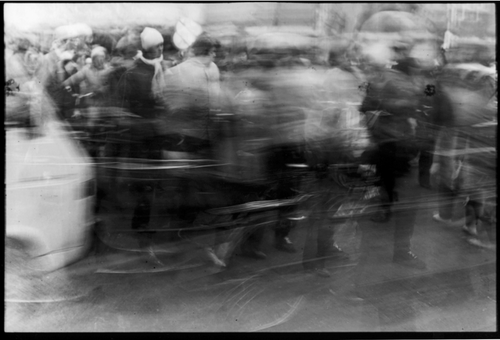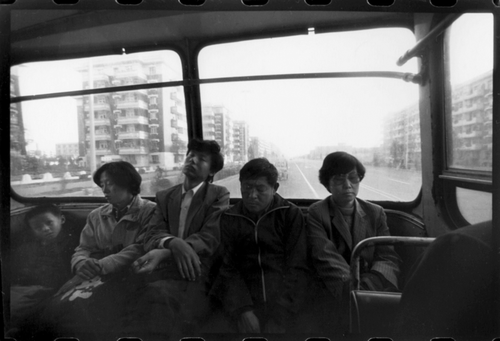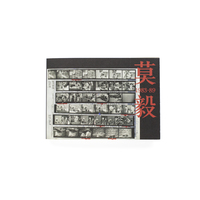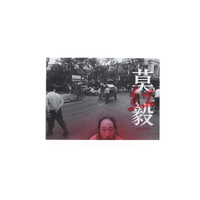MO YI "Eighties Part II: MOYI 1987-1989"
Zen Foto Gallery is pleased to present "Eighties Part II: MOYI 1987-1989" by Chinese photographer Mo Yi.
Mo Yi was born in Tibet in 1958 and began photography entirely self-taught in 1982. In the early 1980s, Mo Yi used a telephoto lens to shoot in a “mop-up” style in the street, both to explore reality and to express himself through photography. Mo Yi has explored a diversity of photographic expressions over the past four decades of his artistic career. In the performance art project “Pictures in a Hutong” (1995-2003) he hung his photos on the wall of a Hutong alley in Tianjin. In “I am a Dog (Eyes of a Dog)” (1995) he fixed his camera onto a mono-pod, nearly touching the ground, and photographed the feet of the crowds of people milling about. In the 2000s his work included collages juxtaposing fragments of colour photographs and photographic installations.
This exhibition marks Mo Yi’s third solo presentation at Zen Foto Gallery, and features the artist’s photographs taken in the 1980s. We have shown Mo Yi's photography from the 1980s in two parts, with 1987 as a watershed. The first exhibition was held in April 2015, with selections from works made before 1987, “Fathers” and “Old Landscapes”. This second exhibition will feature three series; “My Illusory City” (1987), “1m, The Scenery Behind Me” (1988-1989) and “Swing Bus” (1989), taken immediately after the Tiananmen Square protests.
“The end of the 1970s was the time when people in China experienced a cultural tide. Rock music appeared in 1986, and everyone thought that they could overthrow the corrupt government. The 1980s saw the Chinese changing: once they were pure and earnest, then they gradually stepped into chaos and instability, and eventually exploded. In the end they experienced a bloody incident. Soon after that, silence returned again... By 1987, China had already shifted from that pure and earnest society into a restlessness: everyone became irritated.”
ーMo Yi
1987 was the year in which Mo Yi made fundamental changes to his artistic practise; from a straightforward snapshot style to a more experimental creative style. Mo Yi had been photographing with a telephoto lens for many years, but he could no longer bear the need to depend upon “accident”. He was eager to create work without the limitations of tool, time and location. He had doubts over use of the telephoto lens, which only captured part of the reality, while throwing the background and circumstance away from the subject.
As a result, he began his first period of experimentalism with “Riot/Disturbance” (also known as “My Illusory City”), using multiple exposures to depict isolation in the big city. “I shot with the use of the camera like a machine gun. I stepped forward while clicking the shutter, and one film got exposed more than ten times. That is the trace of my feelings and the scenery merging together on the film.” said Mo Yi. Rather than relying upon a hoped for “accident”, he created work out of his personal artistic motivation.
“1m, The Scenery Behind Me” is a series made just before the Tiananmen Square Protests. It originally came from Mo Yi's performance “The Manner of Walking”, in which he placed a camera at the back of his neck on the collar, with the lens facing backward. Holding the shutter release in his hand, he pressed the shutter once while he made five steps. Effectively tying himself together with his fellow countrymen and including himself in the pictures, he expressed himself also as one of the men living in the society's disconsolate atmosphere. “The Swing Bus” was shot inside buses soon after the Tiananmen Square protests in the autumn of 1989; the congealed greyish air and the drifting feeling on the buses could be regarded as reflections of the status of China and of the artist’s mind at the time.
Mo Yi’s techniques are entirely self-taught, and he overturned conventional approaches to photography. He began with a naturalistic style but evolved his approach into one more expressive of living within Chinese society of that time. With his unique perspective and original techniques, Mo Yi was the pioneer who transformed photography from being a documentary medium into a mode of expression. His works from the 1980s are a milestone of Chinese photography. These techniques that he developed in the eighties were also the foundation for the later development of his artistic practise. Mo Yi’s photography never ceases to move on, transforming as if his photograph is China itself.
A photography book “MOYI 1983-1989” is published by Zen Foto Gallery to accompany the exhibition. Including texts by Mo Yi, photographer Kazuo Kitai and publisher Mark Pearson in Japanese, English and Chinese languages.
Related Article
Mo Yi - Eyes that embody ever-changing China
-
 Mo Yi "1m, The Scenery Behind Me", 1988, silver gelatin print © Mo Yi
Mo Yi "1m, The Scenery Behind Me", 1988, silver gelatin print © Mo Yi -
 Mo Yi "1m, The Scenery Behind Me", 1988, silver gelatin print © Mo Yi
Mo Yi "1m, The Scenery Behind Me", 1988, silver gelatin print © Mo Yi -
 Mo Yi "My Illusory City", 1987, silver gelatin print © Mo Yi
Mo Yi "My Illusory City", 1987, silver gelatin print © Mo Yi -
 Mo Yi "Swing Bus", 1989, silver gelatin print
Mo Yi "Swing Bus", 1989, silver gelatin print


